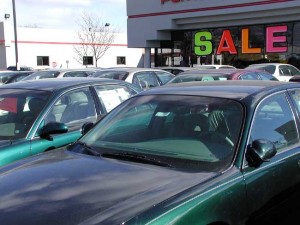If you’re in the market for a used car you might finally be getting good news. Not only are prices taking a dip after several years of record increases, but automotive lenders also are loosening up credit.
The U.S. used car market is huge. By various industry estimates, it’s as much as three times larger than the new vehicle market – which would mean nearly 50 million “previously owned” vehicles will be sold for all of 2013 by franchised dealers, used car lots and individuals. The problem is that the supply dried up during the years following the American economic collapse because with fewer two, three and four-year-old vehicles ready for trade-in, demand outstripped supply.
Now, however, with the new car market heating back up, there are more cars coming off-lease, in particular. And a bigger supply normally translates into reduced prices. According to data tracking site Edmunds.com, the typical used vehicle sold for $15,617 during the third quarter of this year. That was down a sizable 2.8% from the second quarter and, perhaps more significantly, a 0.9% decline from year-earlier prices.
And it doesn’t appear to be an aberration, according to the Manheim Used Vehicle Index which tracks trends at the company’s 69 auction houses. Wholesale prices dipped in October after increasing for the previous four months. The Manheim data, significantly, is adjusted to account for such things as product mix, mileage and seasonal fluctuations that can distort raw figures.
“We don’t need technical analysis to support the notion that the secular trend for wholesale prices is down – the fundamentals are shouting it,” stated the monthly Manheim report.
That said, used vehicle buyers shouldn’t think that they’re guaranteed a bargain if they wait too long. The recovering economy – and the surge in the new vehicle market – suggest that vehicle demand is strong, the auction firm cautioned, which could yet create a supply-and-demand situation favorable to sellers, rather than buyers.
(A battery pickup truck? Maybe, says Tesla CEO. Click Here for the story.)
Indeed, all seven of the big, publicly traded auto dealer groups reported their 17th consecutive monthly increase in used vehicle sales in October.
Careful shoppers, at least for the moment, could find some bargains, according to industry experts. But prices will vary according to segment, cautioned Ricky Beggs, editorial director at the used car data source, The Black Book.
There continues to be concern in the market over the lack of good condition, low mileage vehicles available, primarily due to the overabundance of older-model trade-ins. Translation: you could still pay a premium for some “nearly new” models. But while prices have remained relatively stable for luxury vehicles, Beggs cites “larger-than-normal” declines in the midsize and large truck segments.
(Nissan may expand production base even while adding plants in Mexico and Brazil. Click Here for more.)
Factors contributing to the general downward trend include:
- The increased number of relatively new vehicles, especially those coming off-lease, flooding into showrooms and being advertised in newspapers and online;
- More used cars are being traded in as typical new car buyers who struggled through the recession are now trading in.
And it doesn’t hurt that loan rates not only remain some of the best the market has seen in years but also the fact that lenders are welcoming in more buyers who don’t necessarily have top-tier credit.
(Honda to unveil new hydrogen car at LA Auto Show. Click Here for a sneak peek.)
One key reason: loan delinquency rates have fallen. They were down to 2.58% during the third quarter compared to 2.67% of all auto loans that were delinquent for 30 days or more during the same period in 2012.
“The combination of higher loan balances and relatively flat loan delinquencies is good news for everyone connected to the automotive industry, including consumers, lenders, retailers and manufacturers,” noted Melinda Zabritski, senior director of Automotive Lending for Experian Automotive.
Experian reported that U.S. motorists had $782.9 billion in outstanding new and used auto loans during the third quarter, a whopping $103 billion increase year-over-year.

